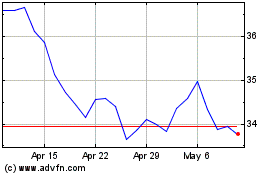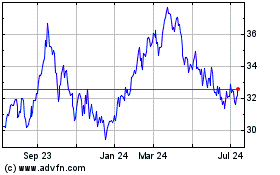By John D. Stoll and Christina Rogers
Auto dealerships grew a bit quieter in May as U.S. consumer
demand for new cars continues to ease, forcing manufacturers to
rely more heavily on sales to rental car and other bulk buyers to
keep production lines humming.
In total, Americans purchased 1.54 million cars and light trucks
last month in the U.S., according to data provider Autodata Corp.,
6% fewer than a year earlier. The drop largely is due to two fewer
selling days last month; sales were up modestly when adjusted for
seasonal factors.
But other key measures fell last month compared with a year ago,
including annualized sales pace and consumer purchases at dealers.
That shift is fueling worries that demand in the world's most
profitable vehicle market has peaked.
The nation's largest auto maker, General Motors Co., which
recently has focused more on retail buyers, posted a sharper
decline than rivals. Toyota Motor Corp. also reported a sales drop,
eroding U.S. market shares for two of the biggest auto makers in
the world in 2016.
Overall, sales to individual consumers fell 10.6% in May,
according to GM. Such sales are considered the best indicator of
market demand.
"They're all just cranking up volume and someone is going to
have to blink," said Mike Sullivan, a Los Angeles-area dealer for
Volkswagen AG, Toyota, and other brands. "They're building too many
vehicles and need to pull back," he said of car makers.
A U.S. stall would be worrisome because other international
markets are shrinking or still trying to recover from the 2008-2009
financial crisis. Russia and Brazil remain down significantly.
China has been offering sales-tax discounts to fuel sales gains,
and Europe only returned to precrisis volumes in April.
Thomas King, a vice president at market researcher J.D. Power,
said U.S. retail sales are flagging because, after six years of
industry sales gains, momentum can no longer be sustained by
available buyers. Pent-up demand has been ample since the financial
crisis, mostly because the industry's nadir was so severe. But that
trend now is being pressured by leased vehicles returning to
dealers, boosting the supply of late model used cars.
Another red flag: Sales incentives crept up 11% last month
compared with the prior May, exceeding $3,000 per vehicle on
average, Autodata reports. Incentives include increased use of
subsidized leases that help keep car payments low even as sticker
prices rise.
Bill Fox, co-owner of Fox Dealerships in Auburn, N.Y., said
there are signs of demand plateauing, and last year's 17.5
million-sales mark is "probably not attainable this year at the
rate we're going unless we see some change."
If retail weakness persists, analysts say auto makers will need
to further boost discounts or cut output levels that have
consistently grown since the financial crisis. Some dealers say it
is time for that to happen.
The overall pace of sales has been slowing since auto makers
notched a string of extraordinary gains in late 2015. May's
seasonally-adjusted annual sales rate, or SAAR, was 17.45 million
vehicles, a healthy number by historic standards, but well behind
the pace set in May 2015 and short of the 18 million-plus level set
late last year. That is discouraging for auto makers who already
have been boosting incentives and rely on Memorial Day bonanzas to
spark the summer selling season.
Fiat Chrysler Automobiles NV and Subaru, which have been riding
high on strong positions in sport-utility vehicles, squeezed out
modest increases to extend their monthly increases to 74 months and
54 months, respectively.
Fiat Chrysler's U.S. sales edged 1.1% higher in May, relying on
its Jeep brand's 14% jump for its growth as the Chrysler, Dodge and
Fiat brands fell from a year ago. Toyota reported a 9.6% sales
decline, Honda Motor Co. sales were off nearly 5%, and Nissan Motor
Co. reported a 1% drop.
For now, substantial gains from fleet buyers who purchase
outside the dealer network is propping up industry sales and
keeping volumes near the record pace set in 2015. Fleet sales last
month increased 13% compared with May 2015.
Fleet sales can be harmful to profits because some are sold at a
discount to rental lots, a practice that erodes margins and
potentially undercuts vehicle resale values. A substantial portion
of fleet sales, however, are booked as lucrative deliveries to
fleet owners needing trucks or vans. Ford Motor Co. sells high
volumes of F-series pickups and Transit vans to government agencies
or construction firms, helping it avoid steering too many models to
rental agencies.
Ford posted a 6.1% decline in May, hurt by a 25% slide in
passenger car sales, which are weak across the industry. Sales of
F-series pickups rose 9%, and Ford vans hit their best tally since
1978. Ford retail sales fell 7%, while fleet sales fell 4%, the
company said.
GM's total sales slid 18% in the month. While its sales have
been declining for months due to a pullback in deliveries to fleet
buyers, the company's retail sales also slipped 13%, mostly due to
fewer selling days and "very tight supplies of new launched
products."
GM has been caught short-handed when it comes to key models,
including a new Cadillac crossover SUV called the XT5. Designed to
replace the outdated SRX in Cadillac's market, the XT5 has been
very slow to reach dealer lots even though luxury crossover SUVs
are among the most in-demand vehicles amid gasoline prices that are
at a decade low, according to AAA.
Rich Walicki, vice president of Jim Winter Buick-GMC-Cadillac in
Jackson, Mich., said he is encouraged by GM's plan to boost truck
output and offer bigger discounts on its pickups and SUVs. Messrs
Walicki and Fox both said sedan volumes remain soft, so it makes
sense to shift production to the heavier vehicles that are
considered GM's sweet spot.
Write to John D. Stoll at john.stoll@wsj.com and Christina
Rogers at christina.rogers@wsj.com
(END) Dow Jones Newswires
June 02, 2016 02:49 ET (06:49 GMT)
Copyright (c) 2016 Dow Jones & Company, Inc.
Honda Motor (NYSE:HMC)
Historical Stock Chart
From Mar 2024 to Apr 2024

Honda Motor (NYSE:HMC)
Historical Stock Chart
From Apr 2023 to Apr 2024
